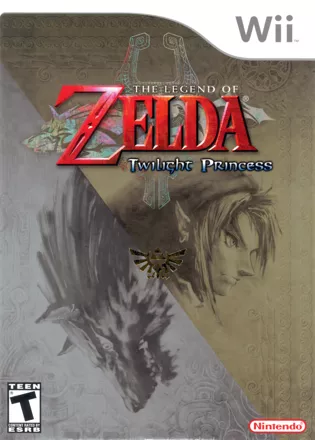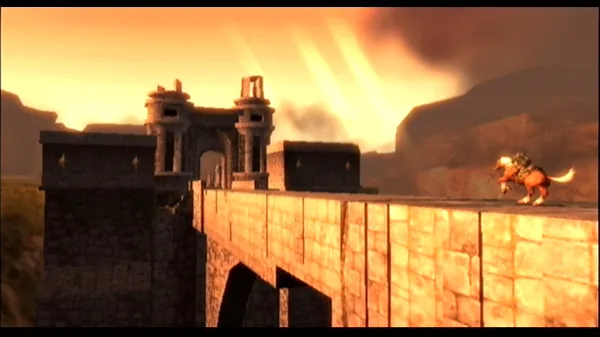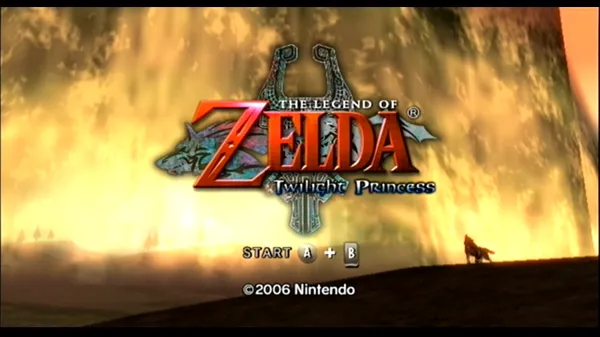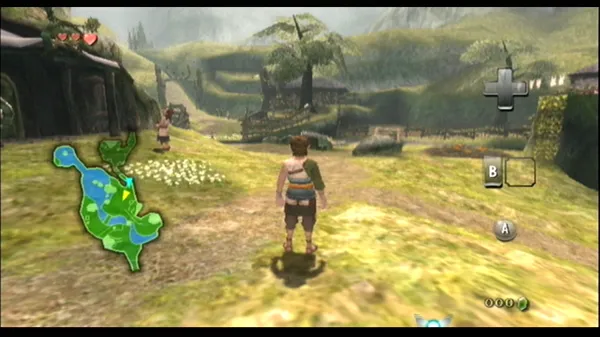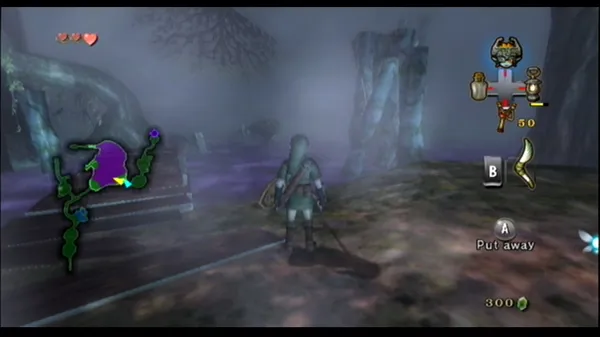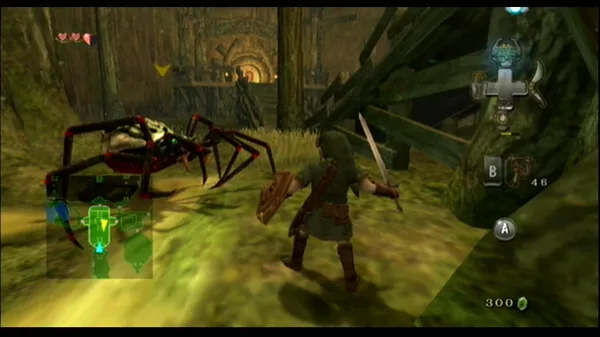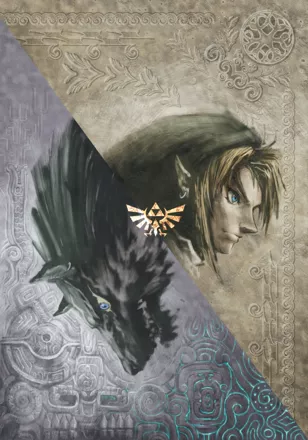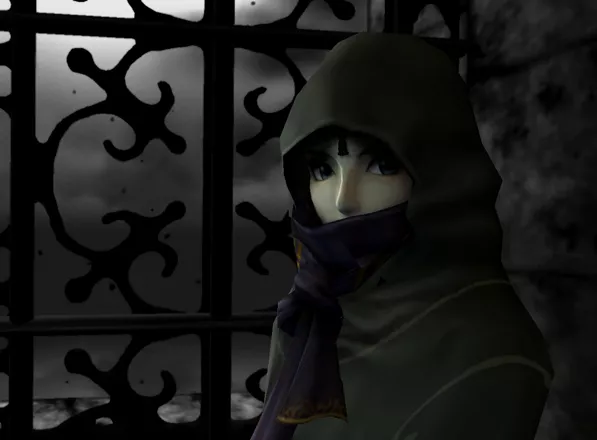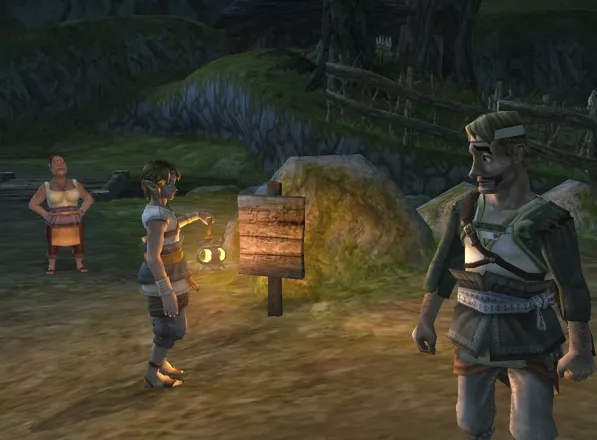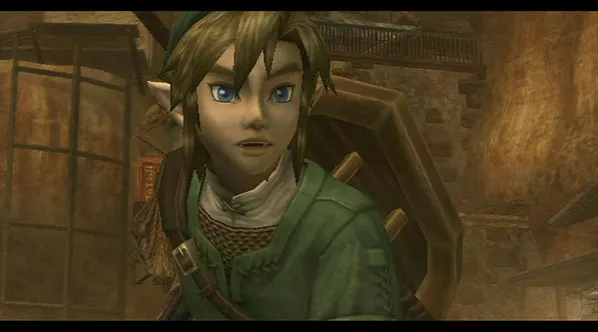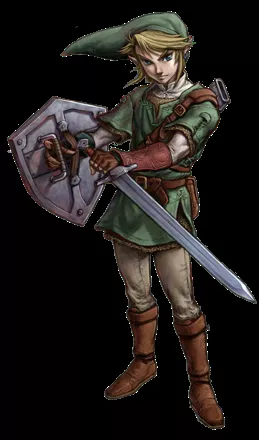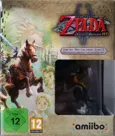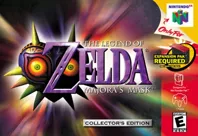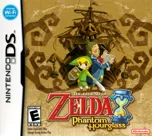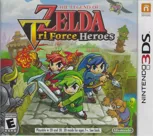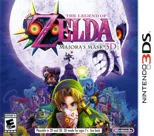The Legend of Zelda: Twilight Princess
Description official descriptions
Twilight Princess is the first Legend of Zelda game for the Wii and also the last for GameCube. At first, Link is a simple farm boy, whose tasks consist of herding goats to watching children in Ordon village, Link's hometown. One day, Link is asked by the mayor to run an errand in Castle Town, but things suddenly go wrong…
The land becomes dark, and strange creatures appear from another world called the Twilight Realm, which turns most into ghosts. Link, however, becomes a wolf. After becoming a wolf, Link is aided by Midna, a resident of the Twilight Realm. Midna helps Link find a way to turn human again along with other tasks.
The wolf cannot use a sword or other items. Instead, as a wolf Link must use his senses to solve puzzles and get past obstacles. The beast can also dig holes to find hearts and rupees and to get in places. It can push blocks with its head to climb higher or reveal hidden passageways. Additionally, it can attack enemies by biting or pouncing on them.
As a human, Link can move around quickly, aim his bow, swing his sword, and even fish. Link also collects many different items, which allow him to perform varied attacks and reach places he couldn't before. Link performs many attacks with his sword and can even learn other sword moves.
The game's art is similar to the naturalistic style of Ocarina of Time, rather than the cel-shaded look of The Wind Waker. Chronologically, the game takes place between the two aforementioned titles, and quite a few locations from Ocarina of Time can be visited. The main adventure takes place in several provinces with dungeons and temples. With the help of Midna, you can easily travel around quickly later in the game.
Spellings
- ゼルダの伝説 トワイライトプリンセス - Japanese spelling
- 젤다의 전설 황혼의 공주 - Korean spelling
Groups +
- Console Generation Exclusives: GameCube
- Console Generation Exclusives: Wii
- Gameplay feature: Arena fighting
- Gameplay feature: Auto-mapping
- Gameplay feature: Beast riding & beast attacking
- Gameplay feature: Day / night cycle
- Gameplay feature: Drowning
- Gameplay feature: Fishing
- Gameplay feature: Herding
- Gameplay feature: Horse riding
- Gameplay feature: Pettable animals
- Gameplay feature: Transformation
- Launch title: Wii (North America)
- Legend of Zelda series
- Nintendo Selects releases
- Protagonist: Elf
- Theme: Werewolves
Screenshots
Promos
Videos
See any errors or missing info for this game?
You can submit a correction, contribute trivia, add to a game group, add a related site or alternate title.
Credits (Wii version)
227 People (188 developers, 39 thanks) · View all
| Director | |
| Sub-Directors | |
| Script | |
| Level Planning | |
| Boss Battle Planning | |
| Data Management | |
| Program Directors | |
| Main Programming | |
| Player Programming | |
| UI System Programming | |
| [ full credits ] | |
Reviews
Critics
Average score: 94% (based on 167 ratings)
Players
Average score: 4.1 out of 5 (based on 231 ratings with 15 reviews)
Nothing new enough to warrant a purchase
The Good
I do like Zelda don't get me wrong. The graphics are pretty good but not exactly ground breaking, the control scheme is nice and I love the new circular inventory system. Hyrule has been overhauled and it is considerably larger than the last time we rambled around it as Link. Puzzles involving transforming between a Wolf and Link are pretty ingenious, look for ghosts pointing to the goal and then transform back into Link to get the job done!.
The Bad
As usual little has changed. The control system has been buffed but has essentially remained unchanged since Ocarina of Time, take away the pointing with the wii-mote and it's same old, same old. There are little new locations, graphics are fairly un-impressive for a next-gen console and most of the items are pretty superfluous. The novelty of changing into a Wolf wears off quickly and admit it, our new buddy is essentially Navi. Most of the music in the game is just a bunch of remixes of old Zelda tunes but there are some new tracks and some of the mini-games are boring (Whoa, let's herd what fun!) and bizzare (giant fruit collecting????).
The Bottom Line
What we have here friends is Zelda; Ganondorf is back (for the six billionth time) and another Link must take up sword and fight for the survival of Hyrule. You can do some new things and there are bells and whistles but essentially it's just the same old formula recycled with a new graphics engine, I definetly wouldn't buy this game it's a renter if anything.
Buy it if you want, I mean you will enjoy it because it's Zelda and it is fun but there just isn't enough that is new to warrant a purchase.
Wii · by AxelStone (34) · 2008
A good game, but a weaker Zelda
The Good
In 2006, Nintendo finally unleashed their latest console on the public, with strong first party support at launch. Of course, everyone got to play Wii Sports, but after everyone was all done swinging, batting, and hitting invisible objects with their newfangled controllers, only two critically acclaimed titles remained on the shelf. One of them was The Legend of Zelda: Twilight Princess. In order to spur sales of their newest console, Nintendo made a last-minute decision to bring the game to the Nintendo Wii, and release it weeks before its Gamecube counterpart, forcing Wii purchases from only the biggest Nintendo fans out there. And it worked. Twilight Princess is one of the best-selling titles in the Zelda series to date, as well as one of the only near-simultaneous multi-console releases in Nintendo history.
Strangely, I somehow missed Twilight Princess when it was first released. Even though I got a Wii console at launch season, the idea of a “dark, mature” Zelda didn’t personally appeal to me, and it didn’t seem necessary for one of my favorite franchises in gaming to go Teen rated. Twilight Princess always passed me by, and I didn’t have a whole lot of interest in playing it until the second Wii Zelda, Skyward Sword was released. After playing Skyward Sword and absolutely loving it to pieces, I wanted to give the Wii’s previous Zelda game a shot and see how it compared to its successor, and the series as a whole. I was a little disappointed at the result.
Twilight Princess acts like a more polished and expansive take on the original 3D Zelda, Ocarina of Time. I got quite a sense of déjà-vu more than once as I made my way through this version of Hyrule. The game feels like a natural extension of the gameplay, visual, and even aural design of the 1998 smash, and it certainly tops it in a lot of ways. That said, it isn’t quite as fresh as other games in the series. If you’ve ever played a Zelda game before, you know what to expect. Find dungeons, get items, solve puzzles, fight bosses, and in general, being the hero du jour. Twilight Princess is no different in that respect. What is different is how big Twilight Princess is. The back of the box doesn’t lie when it says that the game is the biggest Zelda game to date, even five years after the game’s release. You could easily fit most of the other Zelda world maps inside of Twilight Princess’ Hyrule. The world would take a player a good chunk of time to completely walk around (without rolling) and explore all of its regions only on foot. Luckily, you have a horse in this game, and you’ll absolutely need it to get around since on-foot travel is ridiculously slow in Twilight Princess. While it doesn’t compare to other video game fantasy worlds such as Tamriel or Azeroth, Twilight Princess’ world size is very impressive by Zelda standards.
The Wii controls are pretty good. They don’t really immerse you into the experience, which was supposed to be the console’s main selling point, but they do work well for the most part. Rather than having the game accurately track your sword swings, flicking the remote acts as a replacement button for sword swinging. The game doesn’t even attempt to track the direction of your sword, so you can flail away with reckless abandon and Link will take care of the rest. You can actually swing your sword while moving in this game, which helps make the controls feel a bit more fluid. Certain items allow the player to aim them by pointing at the screen. The game tries to allow the player to point at the edges of the screen to rotate the camera, but I found this to be poorly implemented and slow to respond. Other games, even at launch, did a much better job with these type of controls, but Nintendo hadn’t quite figured it out yet. Thankfully, you can at least rotate Link using the Nunchuck, though vertical aiming can still be slow. In addition, it can be a little challenging to keep your cursor pointed at the screen, as when you want to use one of these items, you will have to flail your remote around a bit to try and get your cursor back onto the screen if it’s not already pointing there. Still the pointing controls help to make the game feel more at home on the Wii. The Nunchuck handles camera control and movement, but its motion sensors are used to handle several of Link’s special attacks. Shaking it from left to right activates a spin move, while jabbing it forward does a shield bash. This is one of the rare Wii games to actually use every single last button and function of the Wii controller, which I do love. With two exceptions, this really wasn’t the game to put the Wii’s motion capabilities to the test, but as far as mapping a Gamecube game’s controls for the infant technology, it gets the job done.
By far the most Wii-like element of the game is the fishing, and more specifically, the lure fishing. It almost has a MotionPlus feel to it, as it tracks the angle of your Wii remote for the rod amazingly well, and uses the Nunchuck to reel in. The fishing itself has more depth to it than you would expect, as you can choose several different lures to better attract various kinds of fish. It could have made a great minigame for Wii Sports, and I’m surprised that Nintendo didn’t simply copy it over for either the original or Resort.
As you go through the game, you’ll unlock special sword abilities from a mysterious unnamed character, who looks like an enemy but is actually an ally. There are seven in all, and towards the back half of the game it becomes necessary to actually make use of them, because the enemies are typically decked out in full armor and are much faster. This is a truly wonderful addition to the Zelda series, and I would love to see it expanded in future installments. The biggest new addition to the Zelda formula is the ability to transform into a wolf. In wolf form, Link is less strong and cannot use items but moves much faster, and has a really neat special move which allows you to target several enemies at once. In addition, Link can also dig to enter new areas and uncover treasures, and can activate a special “Senses” mode which allows you to see digging areas and invisible enemies and objects, which can be used to solve puzzles. You also have the ability to warp across Hyrule as a wolf, but for some reason, the game doesn’t let you warp around as a human, which did get a little annoying. If you chose to warp as a human, you would have to transform back again after you warped, which got VERY annoying, especially since Midna, your companion, will complain if you attempt to transform in the sight of friendly characters. On a basic level, it really isn’t terribly different from the transformations in Majora’s Mask, yet playing as a wolf isn’t quite as FUN as any of those, though it certainly trumps being a bunny.
Another feature that I really liked is the ability to calibrate the pointer in-game. I’ve never seen this feature in any Wii game before, and it’s baffling why it hasn’t been in any game that I’ve played since.
The Bad
There were quite a few annoyances that really held this one back from becoming the best Zelda ever. For one, the game introduces great, innovative items in many of the game’s dungeons, then does virtually nothing with them after you’ve completed their debut dungeons. Some items, such as the Ball and Chain and the Gale Boomerang, are literally only used during the level they are featured in, and MAYBE a couple of times in the surrounding area if you’re lucky. There are too many items and not enough locations in Hyrule to actually make use of them.
Speaking of Hyrule, I found that the developers failed to add anything really interesting to the world. Sure, there were SOME hidden caves and areas, but much of Hyrule consists of wide, open spaces connected by narrow channels with literally nothing to see or do. If you’re going to make such a big world, you have to have the gameplay content to match, and Twilight Princess simply doesn’t have enough. At times, the world size is extremely overbearing, as you’re forced to go around Hyrule several times throughout the game. The size of the world can make getting to your next objective somewhat of a dull experience, but with so little to distract you along the way, at least you’ll get there sooner. On the lus side, when you DO manage to find something interesting, it is very rewarding. I just wish there was a bit more to find. The second was that there were too many strange, random things that I felt really didn’t belong in a Zelda game. The opening of the game has you herding goats into a barn. You have to do this twice at the start, and it’s about as interesting as it sounds. I also found the inclusion of sumo wrestling to also be a bit strange in a Zelda game, with awkward and frustrating movement controls making it a chore to play. In addition, several of the towns had too much of a wild west feel to them in terms of look and music, which sticks out like a sore thumb in the medieval fantasy themed game. In general it seems like the art designers went out of their way to make everything look as ugly as possible, which gives the game a gritty, realistic look, but it wasn’t something I personally enjoyed. Give me color and flashy animations, not dirt and grime.
The game doesn’t feel quite as inspired as other Zelda games. At times, Twilight Princess seems to be just going through the motions. In particular, some of the sidequests are just downright boring. In one quest, you’ll have to get 3000 Rupees to raise up money so that one of the Ordon kids can set up a shop in town. Rupees are almost completely worthless in this game, so this is the one sinkhole they can actually fill up. By the time I had beaten the game, I STILL had not completed this sidequest. Even some of the required quests aren’t that great. There’s a really tedious quest where you have to seek out invisible electric bugs as a wolf to get rid of the Twilight. You have to do it three times in the game, with almost no changes or surprises each time.
While Zelda games are not especially known for their stories, they always are engaging on a basic, and sometimes emotional level. At the very least, they’re certainly Nintendo’s best stories. Well, except for Twilight Princess, that is. The story really doesn’t hang together well in Twilight Princess, as many elements aren’t explained or are confusing and important characters and plot threads are dropped or virtually ignored for large sections of the game. Why was the game even called Zelda to begin with? She played virtually no part in this story at all, and yet it’s her name in the title of the game. The ending itself feels rather abrupt and strangely incomplete, and the story as a whole just felt rushed. It would have helped if the cutscenes weren’t so ponderous and slowly paced. I found myself saying “get on with it” for far too many times during the cutscenes, because it wasn’t really holding my attention.
The game’s difficulty feels highly inconsistent. The puzzles and level designs are some of the most grueling of the entire series, perhaps the hardest they have ever been, but the combat feels like a pushover, especially in the boss area. Part of the reason the ending feels underwhelming is that the final boss goes down far too easily. I think that by making the combat feel more fluid, they took away a lot of the challenge that came from the more clunky controls of past Zelda games. Yes, the FEEL is more enjoyable, but you’ll often wish that the enemies were just a little harder as a result.
There is another mini-game called Roll-Goal that is playable at the Fishing Hut. It’s a basic ball-rolling game, but the motion controls are poorly implemented. You are supposed to tilt your remote to place a marble in a cup, but the tilt of your remote doesn’t affect the level of tilt in the game and acts as a digital trigger. Combine that with platforms that are only the size of your marble, and you have an exercise in frustration.
The Bottom Line
Twilight Princess is an undeniably good, and at times great game. Since it’s a Zelda game, I would have expected nothing less. If most Wii games were at least as good as Twilight Princess, then the Wii could possibly have been the best console ever made. But compared to other Zelda titles, Twilight Princess lacks that special “something” that always makes a console Zelda game a one-of-a-kind, standout experience that only happens every few years. In attempting to go dark and edgy, Nintendo loses a bit of the almost child-like sense of wonder that all of their best games have been built upon, also losing some of their creativity in the process.
Wii · by krisko6 (814) · 2012
The Good
This is by far the best Zelda game I have ever played.
Being one who has lived through all the Zelda games to the current date, I can without doubt call this game a masterpiece. I bought this game on Friday, was finished on Sunday evening. I didn't leave the freaking chair, it took me a whole 37 hours to play it through. It is by far the most adrenaline-filled Zelda game that has been launched.
Twilight Princess has beautiful artistic perspective, and one of the best looking Game Cube games to date. There is nothing more fun than shooting an arrow all the way across Hyrule field, then riding your horse trying to find it again. With award winning sound and gameplay, the most in depth plot, great graphics, great artistic perspective, over 60 hours of gameplay, and a character that never talks, The legend of Zelda: Twilight Princess is sure to bring enjoyment to any gamer who appreciates games for what they are, an art.
Twilight Princess amazingly follows through on all of its promises. Nintendo has done what one might consider the unthinkable -- achieved perfection.
The Bad
For some people that have played several Zelda games in the past. This is not a very hard game to finish.
The Bottom Line
There is not a single point where the game is not at an outstanding level. I would like to tell you more about it, and tell you in detail about every feature in the whole game, but...why should I tell you, when you can experience it yourself?
Why should I spoil the greatest adventure of all? The best way to experience all this is to play it yourself. And I do recommend that you do just that, so go buy one, for your own sake, and get the game. You will not be disappointed. Nintendo has created a true masterpiece.
GameCube · by SiriusCrane (8) · 2007
Discussion
| Subject | By | Date |
|---|---|---|
| Android version? | Deleted (13942) | May 18, 2019 |
| Genre Correction | Mark Picard (1) | Jul 9, 2013 |
| Mirrored? | beetle120 (2415) | Nov 25, 2007 |
Trivia
1001 Video Games
The Legend of Zelda: Twilight Princess appears in the book 1001 Video Games You Must Play Before You Die by General Editor Tony Mott.
Delay
The game was originally announced for release for the GameCube in November 2005. This was delayed to November 2006 so that the developers could add more content to the game and release it on the Wii as well as the GameCube.
Development
- During development, Midna's hair was red and green, while in the final version it's red but ends in blonde-yellow.
- Although Sheik, Zelda's ninja-like alter-ego from
Ocarina of Time , does not appear in Twilight Princess, an updated design of the character was drafted up in its development. He is however available as a playable character in the Wii gameSuper Smash Bros.: Brawl .
Characters
Throughout the game you'll encounter the strange Shadow Beasts (the dark blue/black coloured humanoids with the bizarrely shaped disc-heads and tentacle hair). However, in two cut-scenes, you can see two big Shadow Beasts with differently designed disc-heads flanking Zant like bodyguards.They don't appear in-game as enemies.
Glitch
There is a bug in a room with a big cannon Link can use to warp. If you save in that room, an invisible character won't let you leave, but he can't be spoken too. Link can't transform into a wolf either. Customers could return the disc to Nintendo to have it replaced. A video of the glitch is available in the related links section.
Inside Zelda
Nintendo of America's official magazine, Nintendo Power, published a monthly series of articles called Inside Zelda, which revealed how the game was developed. The series can be read in its entirety here.
Inspiration
- The Oocca race appears to be inspired by M.C. Escher's painting Another World.
- The masks worn by the Ancient Sages resemble those worn by chorus members in Ancient Greek dramas.
Midna
The character Midna, who speaks gibberish, is actually speaking English that has been scrambled beyond comprehension. Some of her unscrambled voice lines are related to the game's story whilst others are related to key gameplay elements (such as "I'll take you there with my power", which is used when warping to other areas. This is especially interesting as Midna's voice actress, Akiko Kōmoto is Japanese.
References
- if you look around the fishing hut, the owner, you'll see an old black and white photograph of the Fishing Guy from the Lake Hylia fishing pond from Ocarina of Time. The hut's owner and operator Hena refers to him as the "legendary fisherman" and comments that she may be a descendant of his.
- In Hyrule Castle Town you meet a character named Thelma, who owns a bar in the city and is a fairly important NPC to the storyline. She also owns a cat named Louise, who helps you as well. The two characters are a reference to the movie Thelma & Louise.
- The characters Malo and Talo, children living in Link's hometown Ordon Village, are named references to Malon and Talon from
The Legend of Zelda: Ocarina of Time , who are references to Marin and Tarin fromThe Legend of Zelda: Link's Awakening . - The symbols that represent each Sage are the Six Medallions from The Legend of Zelda: Ocarina of Time.
Version differences
Unlike every other Legend of Zelda game, Link is right handed in Twilight Princess. This is so most people (right handers make up 85% of the population) can make use of the Wii controls in the same hand as Link. Sword in the right, shield in the left. The GameCube version has Link using his left hand as usual. To make the game work for the right handed Link of the Wii, the Wii and GameCube versions of this game have the world map and everything in it mirrored So everything stays the same relative to him.
Awards
- GamePro (Germany)
- February 01, 2007 - Best Console Game in 2006 (Wii version) (Readers' Vote)
- February 01, 2007 - Best Console Action-Adventure in 2006 (Wii version) (Readers' Vote)
- GameSpy
- 2006 – Game of the Year
- 2006 – Console Game of the Year
- 2006 – GameCube Game of the Year
- 2006 – Wii Game of the Year
- 2006 – GameCube Game of the Year (Gamers' Vote)
- 2006 – Wii Game of the Year (Gamers' Vote)
- 2006 – Wii Adventure Game of the Year
- 2006 – Wii RPG of the Year
Information also contributed by Keeper Garrett, Mark Ennis, Sciere and Thomas Dowding
Analytics
Related Sites +
-
Iwata Asks - The Legend of Zelda: Twilight Princess
Nintendo Co., Ltd. president Satoru Iwata interviews Yoshiyuki Oyama, Keisuke Nishimori, Koji Kitagawa, Atsushi Miyagi, Kentaro Tominaga, & Aya Kyogoku of Nintendo EAD's Software Development Department. -
Official Website
website -
Twilight Princess Cannon Room glitch
A video demonstration of the glitch in the cannon room, see the trivia item for more information
Identifiers +
Contribute
Are you familiar with this game? Help document and preserve this entry in video game history! If your contribution is approved, you will earn points and be credited as a contributor.
Contributors to this Entry
Game added by Keeper Garrett.
Android added by firefang9212. GameCube added by Kabushi.
Additional contributors: Sciere, Freeman, gamewarrior, samsam12, —-, Patrick Bregger, Grandy02, FatherJack, Deleted.
Game added November 20, 2006. Last modified February 19, 2025.


